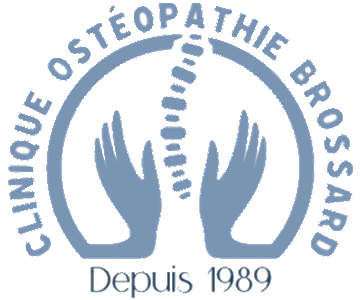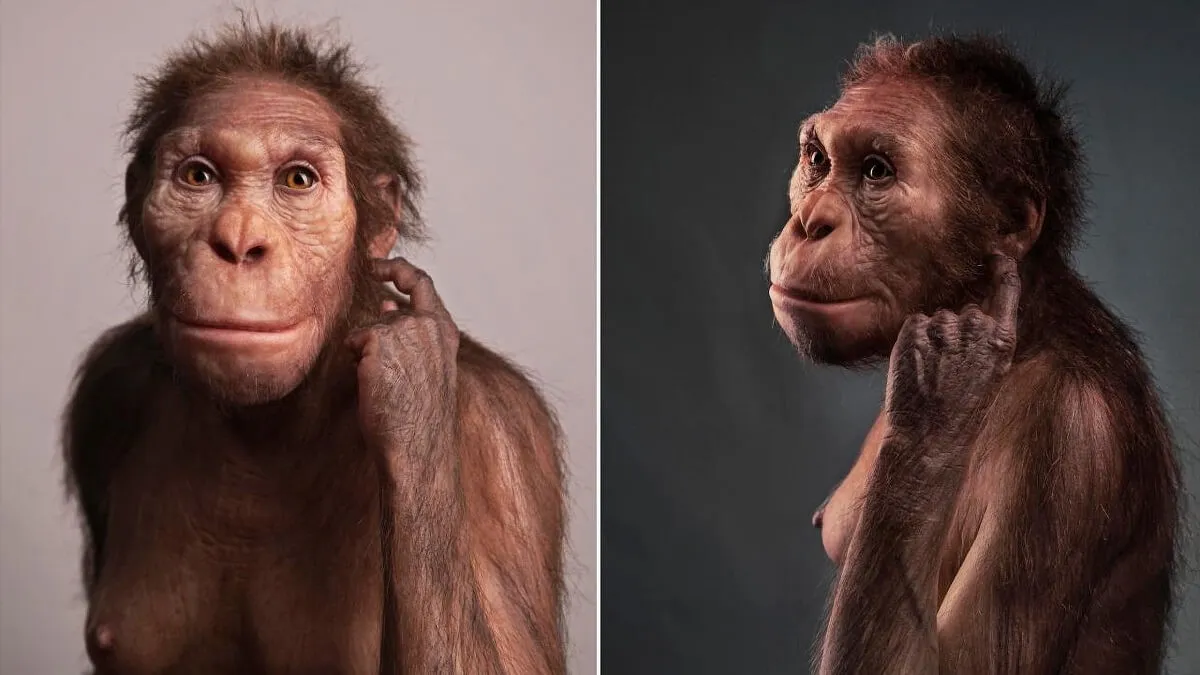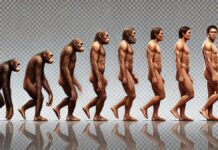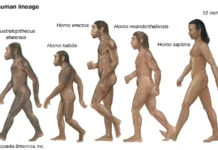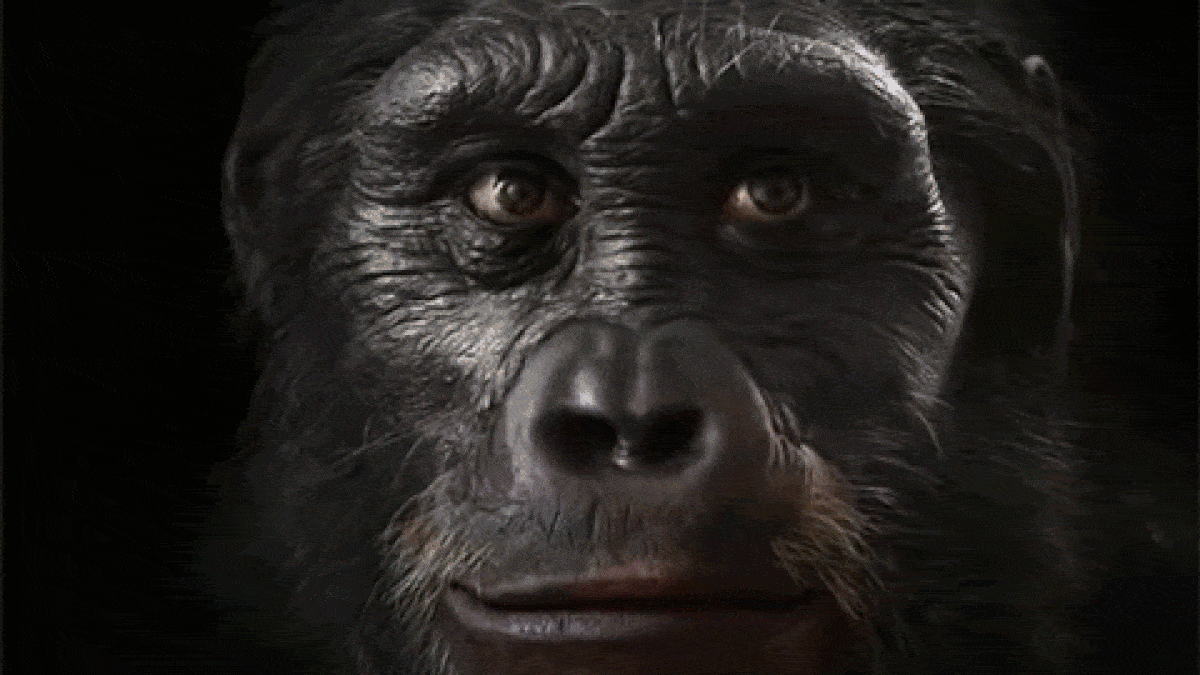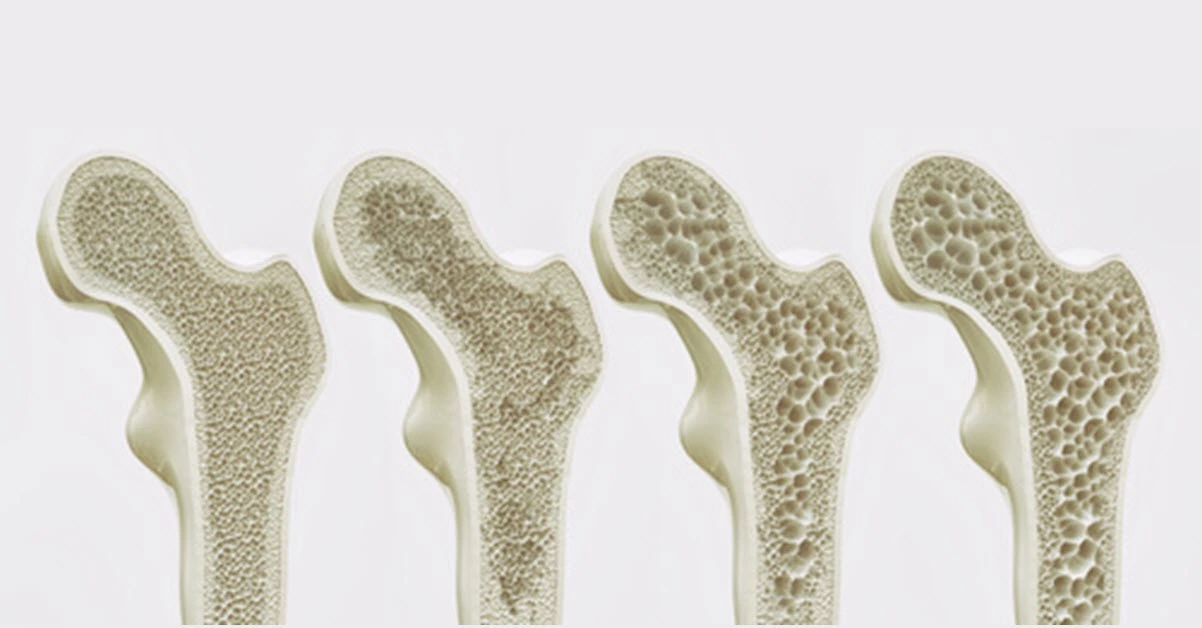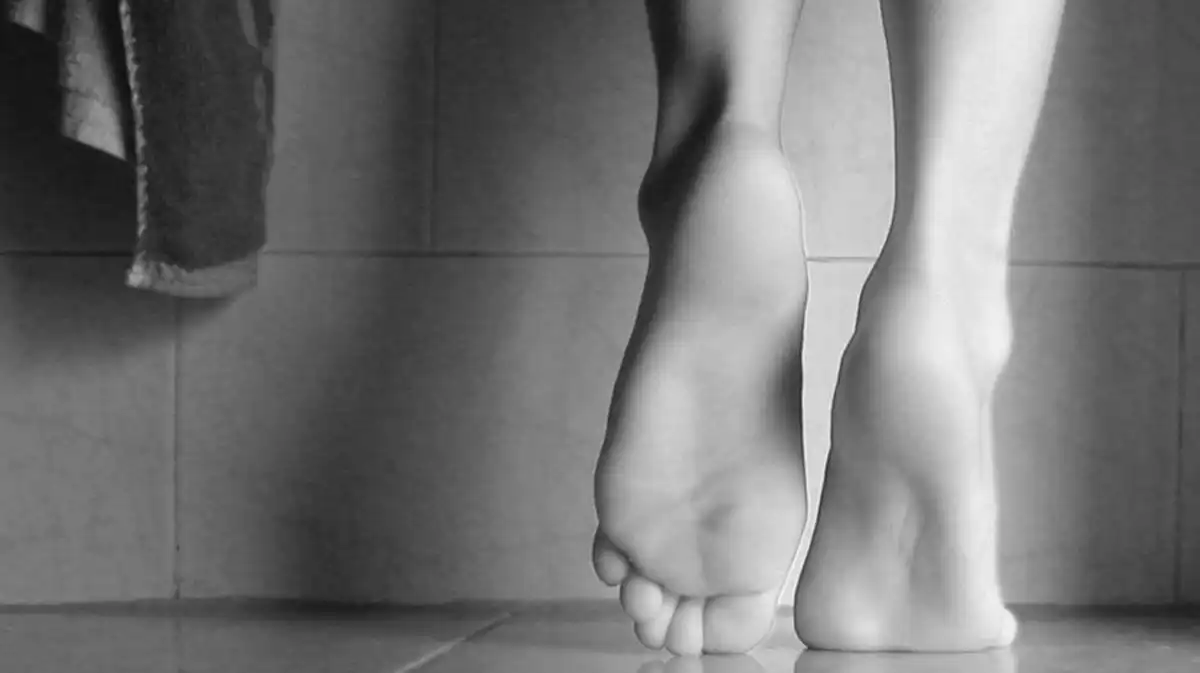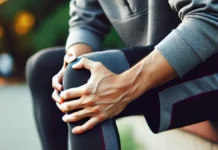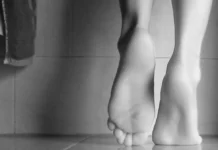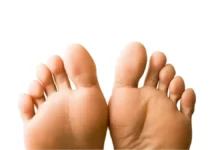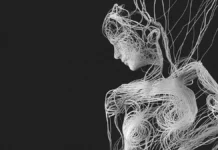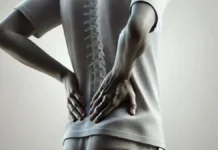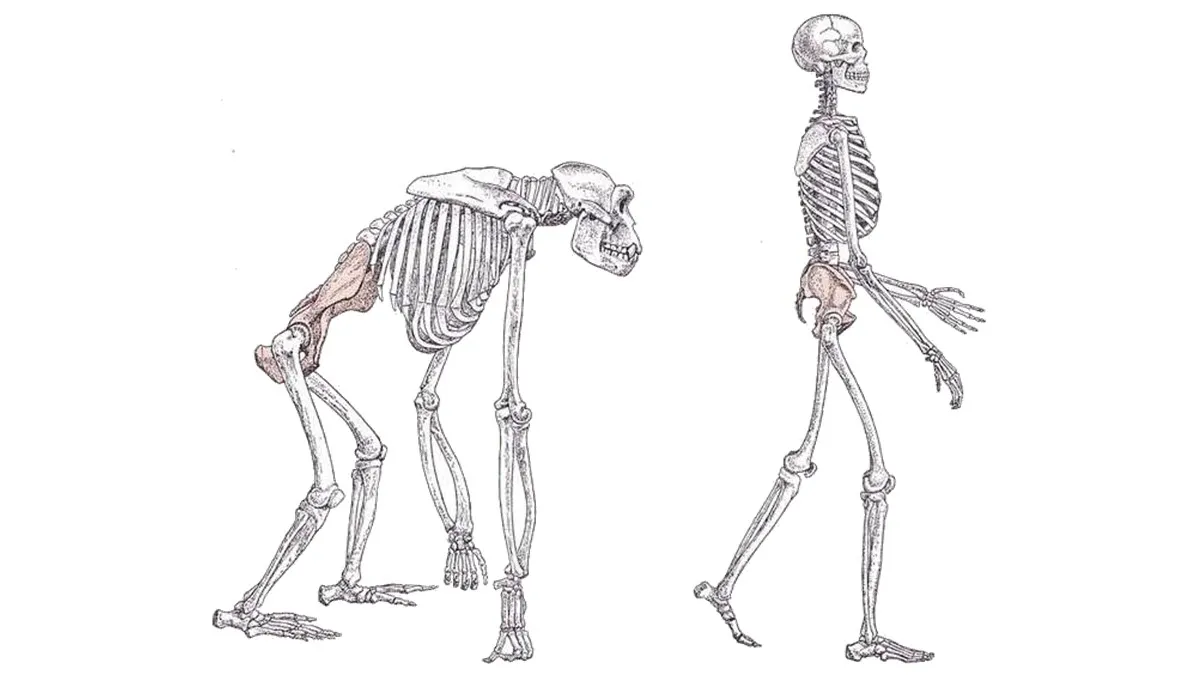Introduction: The Evolutionary Leap to Bipedalism
Imagine a time millions of years ago when our early ancestors moved on all fours, navigating dense forests and open plains with agility and purpose. Life then was dictated by survival—climbing, crawling, and foraging in an environment that demanded constant adaptation. But at some point in our evolutionary journey, a monumental transformation occurred: the shift to bipedalism, or walking upright on two legs. This change, seemingly simple, would forever alter the trajectory of human development.
Bipedalism brought unparalleled advantages, redefining what it meant to be human. Standing tall granted early humans a clearer view of their surroundings, making it easier to spot predators and locate food sources. This elevated perspective likely improved decision-making and survival odds. Additionally, freeing the hands allowed for the development of tool use, a cornerstone of technological and cultural advancement. With tools came the ability to hunt more effectively, prepare food, and manipulate the environment, leading to dramatic shifts in diet and lifestyle. Over time, these changes fueled the growth of larger brains and more complex social structures.
However, as with all evolutionary adaptations, bipedalism came with trade-offs. While it enhanced mobility and efficiency, allowing humans to traverse great distances with less energy, it also placed significant stress on the body. The musculoskeletal system, originally optimized for quadrupedal movement, had to adapt to new challenges. The spine, hips, knees, and feet bore the brunt of these changes, evolving to support an upright posture. This anatomical restructuring, while revolutionary, introduced vulnerabilities that remain evident today.
One major consequence of bipedalism is the increased prevalence of musculoskeletal disorders (MSDs). The spine’s natural curves, essential for maintaining balance, can become sources of discomfort when exposed to prolonged strain or poor posture. Similarly, the knees and hips, key joints for upright locomotion, are prone to wear and tear over time. The feet, now responsible for supporting the full weight of the body, face added pressure, often leading to conditions like plantar fasciitis or flatfoot.
Despite these challenges, the benefits of bipedalism far outweighed the drawbacks in the evolutionary equation. It enabled humans to adapt to diverse environments, fostering innovation and resilience. By understanding the profound impact of bipedalism on our anatomy and health, we can better address the challenges it presents today.
In the following sections, we will explore the intricate relationship between bipedalism and musculoskeletal health. From the remarkable adaptations of the psoas muscle to strategies for maintaining a healthy body in a bipedal world, we’ll delve into the legacy of walking upright—a defining characteristic of what it means to be human.
Benefits of Bipedalism: Standing Tall
The transition to bipedalism was a revolutionary step in human evolution, bringing a range of transformative benefits. Standing upright not only reshaped our anatomy but also fundamentally changed how we interacted with the world. Among the most significant advantages were expanded vision, improved mobility, and the freedom of our hands for complex tasks.
Expanded Vision and Mobility
One of the most immediate benefits of standing tall was the expanded field of vision. By walking on two legs, early humans could see farther across the landscape, an essential advantage for spotting predators or locating food in open environments. This elevated perspective improved survival, enabling our ancestors to anticipate threats and opportunities more effectively.
Mobility also became more efficient. Bipedal locomotion, while initially awkward, eventually evolved into an energy-efficient mode of travel. Unlike quadrupedal movement, walking upright required less energy over long distances, allowing humans to traverse vast terrains in search of resources. This ability to cover more ground contributed to the exploration and eventual colonization of diverse environments, from dense forests to arid savannas.
Additionally, the upright posture freed humans from the need to constantly rely on climbing for navigation. This shift enabled early hominins to venture beyond the trees, making use of open spaces and adopting a more versatile and adaptable lifestyle. The ability to walk upright also allowed for endurance running, a unique human capability that proved invaluable for persistence hunting, a technique involving the pursuit of prey over long distances until it succumbed to exhaustion.
Hands Freed for Complex Tasks
Perhaps the most groundbreaking advantage of bipedalism was the liberation of the hands. No longer required for locomotion, the hands could now focus on tasks requiring fine motor skills. This change unlocked a world of possibilities, including the creation and use of tools, which significantly enhanced hunting, food preparation, and shelter construction.
The newfound dexterity of the hands also played a role in the development of art and communication. From crafting intricate tools to painting on cave walls, the ability to use our hands creatively became a defining feature of humanity. It also paved the way for the use of gestures and sign language, which likely laid the foundation for spoken language.
By freeing the hands and expanding mobility and vision, bipedalism set the stage for the intellectual, cultural, and technological leaps that define modern humans. These advantages not only shaped our physical evolution but also influenced the way we think, interact, and innovate. As we examine the complexities of bipedalism, it becomes clear that its benefits laid the foundation for the success of our species.
Challenges of Bipedalism: Stress on the Body
While bipedalism revolutionized human evolution, enabling a range of benefits from enhanced mobility to tool use, it also came with significant challenges. The shift from quadrupedal locomotion to walking upright placed unique stresses on the human body, particularly on the musculoskeletal system. This section delves into the strain bipedalism imposes on our anatomy and the evolutionary trade-offs that have shaped our adaptations.
The Musculoskeletal System Under Strain
Walking on two legs required significant anatomical changes to support the body in an upright position. The spine, pelvis, knees, and feet underwent substantial adaptations to manage the mechanical demands of bipedal locomotion. However, these changes introduced vulnerabilities that persist to this day.
One of the most affected areas is the spine. To support an upright posture, the human spine evolved an S-shaped curvature, which helps distribute weight evenly and maintain balance. While this adaptation is effective for locomotion, it also makes the spine susceptible to issues such as herniated discs, scoliosis, and lower back pain. Prolonged sitting, poor posture, and heavy lifting further exacerbate these risks in modern lifestyles.
The pelvis also underwent dramatic changes. It became shorter and wider to support the abdominal organs and provide stability during walking and running. However, this reshaping reduced the space available for childbirth, contributing to the complications associated with human labor, a phenomenon known as the “obstetric dilemma.” Furthermore, the pelvic adjustments altered the alignment of the hip joints, increasing the likelihood of hip arthritis and other degenerative conditions.
The knees and feet, tasked with bearing the body’s full weight, are equally affected. The knee joint evolved to lock in place during standing, improving energy efficiency. However, this mechanism places immense pressure on the cartilage and ligaments, increasing the risk of conditions like osteoarthritis, ACL injuries, and patellar tracking disorders. Similarly, the foot, now a rigid structure for propulsion and support, is prone to issues like plantar fasciitis, flat feet, and stress fractures due to overuse or improper footwear.
Trade-Offs in Adaptation
Evolution often involves trade-offs, and bipedalism is no exception. The adaptations that allowed humans to walk upright also came with compromises that left our bodies vulnerable to musculoskeletal disorders (MSDs).
One significant trade-off is the balance between stability and flexibility. The human skeleton and musculature adapted to maintain stability in an upright position, particularly in the spine and pelvis. However, this stability often comes at the expense of flexibility and range of motion. For example, the spine’s S-curve, while necessary for balance, creates stress points that can lead to chronic pain and injury.
Another trade-off involves energy efficiency versus structural durability. Bipedal locomotion is remarkably energy-efficient, allowing humans to travel long distances with minimal effort. However, the repetitive motion of walking and running places wear and tear on the joints over time, contributing to degenerative conditions like arthritis. Unlike quadrupeds, whose weight is distributed across four limbs, bipedal humans concentrate their load on just two legs, amplifying the impact on joints and bones.
Finally, the adaptation of the foot as a rigid platform for propulsion reduced its flexibility, increasing the likelihood of injuries. While the arch structure enhances stability and shock absorption, its failure—whether due to genetics, lifestyle, or injury—can lead to chronic conditions like flat feet or overpronation.
Mitigating the Challenges
Despite these challenges, strategies exist to minimize the strain of bipedalism on the body. Maintaining good posture, using ergonomic tools, and engaging in regular exercise can help strengthen the musculoskeletal system and reduce the risk of injury. Activities like yoga and pilates can improve flexibility and balance, while strength training can bolster joint stability. Additionally, wearing appropriate footwear and avoiding prolonged periods of sitting or standing can alleviate stress on the spine, knees, and feet.
Case Study: The Psoas Muscle
The psoas muscle is a fascinating example of how human anatomy has adapted to bipedalism. Known as the “mighty psoas,” it plays a critical role in maintaining posture, stabilizing the spine, and enabling efficient movement. This case study examines how the psoas evolved from its function in quadrupedal ancestors to its central role in bipedal locomotion, highlighting the trade-offs between power, stability, and range of motion.
From Quadruped to Bipedal: A Shift in Muscle Function
In quadrupedal animals, the psoas muscle primarily functions as a stabilizer and flexor of the hip, aiding in climbing and walking on all fours. Its structure and composition in early ancestors were adapted for sustained, low-intensity activities such as tree-climbing and navigating uneven terrains. Quadrupeds typically have a higher proportion of slow-twitch muscle fibers in the psoas, which are designed for endurance over long periods.
The transition to bipedalism, however, brought about significant changes in the psoas muscle’s role. With the shift to an upright posture, the psoas became a key player in hip flexion, allowing humans to lift their legs during walking, running, and climbing. This required a shift in its muscle fiber composition, favoring more fast-twitch fibers to support the explosive power needed for bipedal locomotion. The repositioning of the pelvis and spine also altered the angles at which the psoas operates, enhancing its ability to maintain balance and forward momentum.
Despite its adaptations, the psoas is still subject to the constraints imposed by our evolutionary history. Its dual role as both a stabilizer and a mover creates a complex dynamic. When functioning optimally, the psoas contributes to smooth and efficient movement. However, when tight or weak, it can disrupt the delicate balance of the musculoskeletal system, leading to issues such as lower back pain or hip discomfort.
The Trade-Off: Power, Stability, and Range of Motion
The evolutionary trade-offs of bipedalism are evident in the psoas muscle. As humans transitioned to walking upright, the need for stability in the lower back and pelvis became paramount. The psoas had to adapt to support this stability while still enabling the powerful hip flexion required for mobility. This dual role creates a delicate balance between power and stability, with potential consequences for range of motion.
To support an upright posture, the psoas muscle exerts a stabilizing force on the lumbar spine. This stability is essential for preventing excessive movement and maintaining the spinal curves that allow humans to walk efficiently. However, this stabilization comes at a cost. The need for a strong, stabilizing psoas can sometimes lead to tightness or overuse, limiting its range of motion and contributing to musculoskeletal disorders. For example, a tight or shortened psoas can pull the lumbar spine into excessive lordosis (inward curvature), increasing the risk of lower back pain.
Moreover, the psoas’s role in power generation—such as during running or climbing—places significant demands on its capacity to contract and relax efficiently. If the muscle becomes overactive or fatigued, it can lead to compensatory patterns in other muscles, further exacerbating the risk of injury. This highlights the importance of maintaining a balance between flexibility, strength, and endurance in the psoas to ensure both stability and mobility.
Practical Implications for Musculoskeletal Health
Understanding the unique challenges faced by the psoas muscle underscores the importance of preventive care and targeted exercises. Stretching and strengthening the psoas can help maintain its flexibility and functionality, reducing the risk of tightness or weakness. Yoga poses like the lunge stretch or pigeon pose are particularly effective for lengthening the psoas, while core-strengthening exercises can enhance its stabilizing role.
Additionally, proper posture and ergonomics play a crucial role in minimizing strain on the psoas. Sitting for prolonged periods, a common issue in modern life, can cause the psoas to shorten and weaken, leading to discomfort and postural imbalances. Regular movement and stretching breaks can help counteract these effects, promoting a healthier and more resilient musculoskeletal system.
Other MSD Risks Linked to Bipedalism
The transition to bipedalism has influenced other aspects of our musculoskeletal system, potentially impacting our susceptibility to various MSDs:
Bipedalism, while advantageous in many ways, also imposes unique stresses on the musculoskeletal system, particularly on the spine. Here are some other musculoskeletal disorder (MSD) risks associated with bipedalism:
List of MSD risks with bipedalism:
- Lower Back Pain: The shift to bipedalism alters the dynamics of the spine and its supporting muscles. The lower back, or lumbar region, often bears the brunt of this change due to increased pressure from gravity and the need to stabilize the torso in an upright position.
- Intervertebral Disc Degeneration: The upright posture places continuous pressure on the intervertebral discs, which act as cushions between the vertebrae. Over time, this pressure can lead to wear and tear, contributing to disc degeneration and potentially causing conditions like herniated discs.
- Kyphosis and Lordosis: Bipedalism requires maintaining a balanced posture, which can lead to exaggerated curvatures of the spine. Kyphosis, an excessive outward curvature of the thoracic spine (rounding of the upper back), and lordosis, an excessive inward curvature of the lumbar spine (swayback), can result from biomechanical adaptations to bipedal locomotion.
- Muscle Imbalances: The muscles supporting the spine and pelvis must work synergistically to maintain stability during bipedal locomotion. However, prolonged sitting or standing in unnatural positions can lead to muscle imbalances, weakening some muscles while overworking others, which can contribute to MSDs.
- Sciatica: Bipedalism can exacerbate pressure on the sciatic nerve, which runs from the lower back down the legs. Compression or irritation of the sciatic nerve can result in pain, tingling, or numbness radiating from the lower back through the buttocks and down the legs.
- Hip Flexor Tightness: Bipedalism can lead to tightness in the hip flexor muscles due to the repetitive motion of walking and standing. This tightness can contribute to hip and lower back pain and affect pelvic alignment.
- Knee Strain: The repetitive impact of bipedal locomotion can strain the knee joints, potentially leading to conditions such as patellofemoral pain syndrome or osteoarthritis, especially if there are imbalances in muscle strength or alignment issues.
- Foot and Ankle Problems: Bipedalism places significant stress on the feet and ankles, increasing the risk of conditions such as plantar fasciitis, Achilles tendonitis, and ankle sprains due to overuse, improper footwear, or biomechanical issues.
- Balance Issues: Maintaining balance while walking upright requires coordination between multiple muscle groups and sensory systems. Impaired balance can increase the risk of falls and related MSDs, especially in older adults or individuals with neurological conditions.
- Spinal Compression: The gravitational forces acting on the spine during bipedal activities can lead to compression of the vertebral bodies and spinal discs, potentially contributing to degenerative changes and spinal stenosis over time.
- Postural Deviations: Bipedalism requires constant postural adjustments to maintain equilibrium, which can predispose individuals to develop postural deviations such as forward head posture, rounded shoulders, or pelvic tilt, leading to MSDs and discomfort.
- Muscle Fatigue and Overuse: The repetitive nature of walking and standing can lead to muscle fatigue and overuse injuries, particularly in the muscles of the lower back, legs, and feet, increasing the risk of strains, sprains, and tendonitis.
- Joint Degeneration: Over time, the repetitive loading of joints during bipedal activities can contribute to joint degeneration, leading to conditions such as osteoarthritis, especially in weight-bearing joints like the hips, knees, and lumbar spine.
- Neck and Shoulder Tension: Maintaining an upright posture while walking or standing can cause tension and stiffness in the muscles of the neck and shoulders, potentially leading to musculoskeletal pain and discomfort, particularly in individuals who spend prolonged periods in sedentary or desk-bound positions.
- Impact on the Central Nervous System: Bipedal locomotion involves complex neural control and coordination, with the central nervous system orchestrating movement patterns and balance. Dysfunction or injury to the central nervous system can affect gait mechanics and increase the risk of falls and related MSDs.
- Sacroiliac Joint Dysfunction: Bipedal locomotion can place stress on the sacroiliac joints, which connect the sacrum to the pelvis. Dysfunction or instability in these joints can lead to pain and discomfort in the lower back, hips, and buttocks.
- Pelvic Floor Dysfunction: The upright posture required for bipedalism can affect the function of the pelvic floor muscles, potentially leading to conditions such as pelvic organ prolapse, urinary incontinence, or pelvic pain syndromes.
- Varicose Veins: Prolonged standing or walking in an upright position can impede venous return from the lower extremities, increasing the risk of developing varicose veins due to pooling of blood in the veins, particularly in individuals with predisposing factors such as obesity or genetics.
- Degenerative Joint Disease: Bipedalism places continuous stress on weight-bearing joints such as the hips, knees, and ankles, which can accelerate the degenerative changes associated with conditions like osteoarthritis, leading to pain, stiffness, and functional impairment.
- Muscle Atrophy: Prolonged periods of inactivity or sedentary behavior, common in modern lifestyles, can lead to muscle atrophy, particularly in the muscles supporting posture and locomotion, increasing the risk of MSDs and functional limitations.
- Nerve Compression Syndromes: The compression of nerves in the spine or peripheral nerves due to postural abnormalities or repetitive movements associated with bipedalism can result in conditions such as carpal tunnel syndrome, cubital tunnel syndrome, or radiculopathy, causing pain, weakness, and sensory disturbances.
- Temporomandibular Joint (TMJ) Dysfunction: The alignment of the head and neck during bipedal activities can affect the function of the temporomandibular joint, potentially leading to symptoms such as jaw pain, clicking or popping sounds, and difficulty chewing or opening the mouth fully.
- Bone Density Loss: Bipedalism may reduce the mechanical loading on bones compared to quadrupedal locomotion, potentially leading to decreased bone density over time, especially in weight-bearing bones such as the spine, hips, and legs, increasing the risk of osteoporosis and fractures.
- Tendinopathies: The repetitive nature of bipedal activities can predispose individuals to develop tendinopathies, such as Achilles tendinopathy or patellar tendinopathy, due to overuse or biomechanical factors, leading to pain, swelling, and impaired function.
- Psychological Factors: Chronic musculoskeletal pain and disability associated with bipedalism can impact psychological well-being, contributing to conditions such as depression, anxiety, or stress, which in turn can exacerbate pain perception and disability.
- Facet Joint Syndrome: The facet joints in the spine undergo repetitive stress during bipedal activities, which can lead to facet joint syndrome characterized by pain, stiffness, and reduced mobility in the affected spinal segments.
- Rotator Cuff Injuries: While primarily associated with upper limb movements, the rotator cuff muscles also play a role in stabilizing the shoulder girdle during walking and other bipedal activities. Overuse or improper biomechanics can lead to rotator cuff injuries, causing shoulder pain and dysfunction.
- Iliotibial Band Syndrome: Bipedal activities like walking or running can result in friction and irritation of the iliotibial band, a thick band of connective tissue that runs along the outside of the thigh. This can lead to iliotibial band syndrome, characterized by pain on the outer side of the knee or hip.
- Bunion Formation: The repetitive pressure and weight-bearing associated with bipedalism can contribute to the development of bunions, particularly in individuals with biomechanical abnormalities or improper footwear, leading to pain and deformity at the base of the big toe.
- Cervical Radiculopathy: Bipedalism requires maintaining an upright posture, which can exacerbate cervical spine issues such as cervical radiculopathy, where nerves in the neck are compressed or irritated, leading to pain, numbness, and weakness radiating down the arms.
- Stress Fractures: Bipedal activities, especially those involving repetitive impact or sudden increases in intensity, can predispose individuals to stress fractures, particularly in weight-bearing bones such as the tibia, metatarsals, or femoral neck, causing localized pain and swelling.
- Scoliosis: While not directly caused by bipedalism, the asymmetrical loading of the spine during upright posture can exacerbate preexisting spinal curvature or contribute to the development of scoliosis, characterized by lateral curvature of the spine and associated musculoskeletal imbalances.
- Muscle Strains: The dynamic nature of bipedal activities involves the coordinated contraction and relaxation of numerous muscles. However, sudden movements, overexertion, or inadequate warm-up can lead to muscle strains, causing pain and dysfunction in the affected muscle groups.
- Nerve Entrapment Syndromes: Bipedal activities can increase the risk of nerve entrapment syndromes, where nerves become compressed or entrapped along their course, leading to symptoms such as pain, tingling, or numbness along the distribution of the affected nerve.
- Osteochondritis Dissecans: Repetitive loading and stress on the joints during bipedal activities can predispose individuals, particularly adolescents, to osteochondritis dissecans, a condition where a fragment of bone and cartilage becomes detached within the joint, causing pain, swelling, and restricted motion.
- Hamstring Strains: The hamstrings play a crucial role in stabilizing the pelvis and extending the hip during walking and running. Overstretching or sudden movements can lead to hamstring strains, causing pain and reduced mobility in the back of the thigh.
- Tarsal Tunnel Syndrome: Similar to carpal tunnel syndrome in the wrist, tarsal tunnel syndrome involves compression of the posterior tibial nerve as it passes through the tarsal tunnel in the ankle. This can result in pain, tingling, or numbness in the foot and toes.
- Hip Labral Tears: The hip labrum is a ring of cartilage that provides stability and cushioning to the hip joint. Bipedal activities, especially those involving repetitive twisting or pivoting motions, can lead to hip labral tears, causing groin pain and limited hip mobility.
- Piriformis Syndrome: The piriformis muscle, located deep in the buttocks, can become tight or inflamed due to overuse or biomechanical factors, leading to piriformis syndrome characterized by buttock pain that may radiate down the back of the leg (sciatica-like symptoms).
- Foot Pronation Issues: Excessive foot pronation, where the arches of the feet collapse inward during weight-bearing activities, can lead to biomechanical imbalances and increase the risk of conditions such as flat feet, plantar fasciitis, and shin splints.
- Claw Toe Deformity: Prolonged wearing of ill-fitting footwear or biomechanical abnormalities can contribute to the development of claw toe deformity, where the toes curl downward due to imbalance in the muscles and tendons of the foot.
- Coccydynia: Bipedal activities can exacerbate coccydynia, or tailbone pain, particularly in individuals with poor posture, trauma to the coccyx, or repetitive strain on the pelvic floor muscles.
- Trigger Points: Bipedal activities can lead to the development of trigger points, or localized areas of muscle tension and tenderness, particularly in muscles subjected to repetitive use or sustained postures, contributing to musculoskeletal pain and dysfunction.
- Patellar Tracking Disorders: Bipedal activities, especially those involving repetitive bending and straightening of the knee, can lead to patellar tracking disorders, where the kneecap (patella) does not properly align within the femoral groove, causing pain and instability in the knee joint.
- Bursitis: The repetitive friction and pressure on bursae (fluid-filled sacs that cushion and reduce friction between bones and soft tissues) during bipedal activities can lead to bursitis, inflammation of the bursae, resulting in localized pain, swelling, and tenderness.
Positive Achievements of Bipedalism
Bipedalism, the defining characteristic of human locomotion, revolutionized our evolutionary path. Walking upright not only reshaped our anatomy but also granted us significant advantages that contributed to our success as a species. Among the most impactful achievements are enhanced energy efficiency and the ability to explore and adapt to diverse environments.
Enhanced Energy Efficiency
One of the greatest advantages of bipedalism is its energy efficiency. Compared to quadrupedal locomotion, walking upright on two legs consumes less energy over long distances. This efficiency stems from several key adaptations:
- Efficient Mechanics of Walking
The bipedal gait allows humans to use a pendulum-like motion while walking, minimizing energy expenditure. As one leg swings forward, the other supports the body’s weight, creating a rhythm that conserves energy. This mechanism enables humans to travel great distances with less fatigue compared to other forms of locomotion. - Adaptations for Endurance
The evolution of the human body optimized it for endurance activities. Features such as longer legs, shorter toes, and an arch in the foot provide stability and propulsion, making walking and running more efficient. These adaptations were crucial for early humans who needed to cover vast areas in search of food, water, and shelter. - Reduced Energy Costs of Posture
The upright posture allows the body to conserve energy while standing and moving. Unlike quadrupeds, which expend energy supporting their torsos with four limbs, humans rely on the alignment of the spine, pelvis, and lower limbs to maintain balance with minimal muscular effort.
This energy efficiency was vital for survival in ancient environments where resources were scarce. It allowed early humans to forage, hunt, and migrate with greater effectiveness, giving them a significant edge over competitors.
Evolutionary Advantages in Exploration
Bipedalism also facilitated exploration, enabling humans to adapt to a wide range of environments. Walking upright freed the hands for tasks like carrying tools, gathering food, and building shelters, increasing survival and adaptation capabilities.
Facilitation of Migration
The efficiency of bipedalism made long-distance migration feasible, allowing humans to follow seasonal food sources and adapt to changing climates. This mobility was essential for survival during periods of environmental shifts, such as the Ice Age, and contributed to the global spread of early human populations.
Colonization of Diverse Habitats
Bipedal locomotion allowed early humans to move efficiently across various terrains, from dense forests to open savannas. This mobility enabled them to expand their range and exploit new ecosystems. Over time, humans became one of the most widely distributed species on the planet, thriving in environments as diverse as deserts, tundras, and tropical rainforests.
Improved Environmental Awareness
Standing upright provided an elevated vantage point, enhancing the ability to scan the surroundings for predators, prey, or other resources. This improved situational awareness likely increased survival rates, particularly in open landscapes where visibility was crucial.
Advancements in Tool Use and Technology
The transition to bipedalism freed the hands, which played a pivotal role in the development of tools and technology. With hands unoccupied by locomotion, early humans could manipulate objects, craft tools, and develop skills that required fine motor control. This ability not only improved hunting and gathering efficiency but also fostered cultural and technological evolution.
List of positive achievements
- Efficient Locomotion: Walking on two legs allows humans to travel long distances more efficiently than quadrupeds, enabling exploration, migration, and the colonization of diverse environments.
- Manual Dexterity: Bipedalism frees the hands for complex tasks such as tool use, manipulation of objects, and fine motor skills, facilitating technological advancements, craftsmanship, and cultural expression.
- Expanded Field of Vision: Standing upright provides a higher vantage point, enhancing situational awareness, predator detection, and tool use by allowing humans to survey their surroundings more effectively.
- Energy Efficiency: Bipedal locomotion consumes less metabolic energy compared to quadrupedal movement over long distances, enabling humans to sustain activities such as foraging, hunting, and gathering for extended periods.
- Enhanced Thermoregulation: Walking upright reduces the body surface area exposed to direct sunlight, aiding in thermoregulation and heat dissipation, particularly in hot environments, thereby enhancing endurance and survivability.
- Social Signaling: Bipedal posture exposes facial expressions, gestures, and body language more prominently, facilitating communication, cooperation, and social bonding among individuals within communities.
- Endurance Running: Bipedalism paved the way for the evolution of endurance running, allowing humans to engage in persistence hunting strategies, track prey over long distances, and secure animal protein for sustenance.
- Cognitive Development: The energy savings associated with bipedal locomotion may have contributed to the expansion of the human brain, fostering cognitive development, problem-solving abilities, and innovation throughout our evolutionary history.
- Cultural Complexity: Bipedalism facilitated collaborative activities, knowledge transmission, and cultural exchange among human populations, leading to the development of complex societies, languages, traditions, and belief systems.
- Adaptability and Resilience: The versatility of bipedal locomotion allowed humans to adapt to diverse environments, climates, and ecological niches, demonstrating our species’ resilience and capacity for survival in dynamic landscapes.
- ool Use and Innovation: Bipedalism facilitated the development and refinement of tools and technology, enabling humans to adapt to diverse environments, exploit resources, and improve their quality of life.
- Enhanced Hunting Strategies: Walking upright allowed humans to employ sophisticated hunting strategies such as ambush hunting, stalking, and coordinated group hunting, increasing their efficiency and success in securing prey.
- Improved Communication: Standing upright may have enhanced vocal communication by enabling clearer articulation of speech sounds and facilitating social interactions, cooperation, and cultural exchange among individuals.
- Environmental Adaptation: Bipedalism enabled humans to thrive in a wide range of habitats, from forests and grasslands to savannas and deserts, showcasing our species’ adaptability and resilience in dynamic environments.
- Parental Care: The ability to carry infants while walking upright freed caregivers’ hands for other tasks, promoting parental care, bonding, and the transmission of knowledge and cultural traditions within communities.
- Long-Term Memory: Bipedalism may have contributed to the development of spatial memory and navigation skills, as humans traversed varied landscapes, memorized landmarks, and communicated spatial information within social groups.
- Enhanced Social Cohesion: Walking upright fostered social cohesion and cooperation among group members, facilitating activities such as communal food sharing, childcare, and cooperative defense against predators and rivals.
- Symbolic Thinking: Bipedalism may have played a role in the emergence of symbolic thinking and abstract reasoning, as humans used gestures, body language, and artistic expressions to convey meaning and communicate complex ideas.
- Cultural Transmission: Walking upright allowed for the transmission of cultural knowledge, skills, and traditions across generations, fostering cultural continuity, innovation, and adaptation to changing environments.
- Resource Acquisition: Bipedalism enabled humans to gather resources such as food, water, and raw materials more efficiently, contributing to the development of trade networks, economic systems, and specialization of labor.
- Increased Social Status: Standing upright may have conferred social status and dominance within human communities, as individuals with greater height and stature were perceived as more powerful, authoritative, and influential.
- Enhanced Problem-Solving Skills: Walking upright necessitated navigating obstacles, solving spatial challenges, and adapting to changing environmental conditions, fostering problem-solving skills and cognitive flexibility in humans.
- Cultural Diversity: Bipedalism facilitated cultural diffusion and interaction among geographically dispersed human populations, leading to the proliferation of diverse languages, traditions, and belief systems around the world.
- Innovative Shelter Construction: The ability to carry and manipulate objects while walking upright enabled humans to construct shelters, dwellings, and structures for protection, storage, and communal living, enhancing their safety and comfort.
- Ritualistic Behaviors: Bipedalism may have contributed to the development of ritualistic behaviors, ceremonies, and religious practices, as humans gathered in communal spaces, performed symbolic gestures, and celebrated shared beliefs and values.
Strategies for a Healthy Bipedal Life
Understanding the link between bipedalism and MSDs doesn’t mean we’re doomed to a life of backaches and knee pain. Here are some strategies to minimize the risks and promote a healthy musculoskeletal system:
List of startegies
- Strengthening Core Muscles: A strong core, including the psoas, provides stability and support for the spine, potentially reducing back pain risk.
- Maintaining Flexibility: Regular stretching exercises can help keep the psoas and other muscles flexible, reducing tightness and improving range of motion.
- Ergonomics: Practicing good posture and ergonomics while sitting, standing, and lifting can minimize stress on the spine and joints.
- Low-Impact Activities: Activities like swimming or cycling can provide exercise benefits with less impact on the joints compared to running or jumping.
- Maintain Proper Posture: Good posture is essential for distributing weight evenly across the body and reducing strain on the muscles and joints. Practice standing and sitting with a straight spine, shoulders relaxed, and chin parallel to the ground.
- Engage in Regular Exercise: Incorporate a variety of exercises into your routine to strengthen muscles, improve flexibility, and enhance overall musculoskeletal health. Include activities that target core stability, balance, strength, and flexibility.
- Take Frequent Breaks: If your job or daily activities require prolonged standing or sitting, take regular breaks to stretch and change positions. Movement helps prevent muscle stiffness and reduces the risk of developing MSDs.
- Use Ergonomic Equipment: Ensure your workspace, furniture, and equipment are ergonomically designed to support proper posture and reduce strain on the body. Adjust your chair, desk, and computer monitor to promote optimal alignment and comfort.
- Wear Supportive Footwear: Choose footwear that provides adequate support and cushioning for your feet, especially if you spend long hours standing or walking. Properly fitted shoes can help maintain foot alignment and reduce the risk of foot-related MSDs.
- Practice Mindful Movement: Pay attention to your body mechanics during daily activities like walking, lifting, and bending. Use proper lifting techniques, avoid twisting motions, and listen to your body’s signals to prevent overexertion and injury.
- Stay Hydrated and Nourished: Maintain a balanced diet and stay hydrated to support healthy bones, muscles, and joints. Adequate hydration and nutrition are essential for maintaining optimal musculoskeletal function and preventing tissue breakdown.
- Incorporate Stretching and Mobility Exercises: Include regular stretching and mobility exercises in your routine to improve flexibility, reduce muscle tension, and prevent stiffness. Focus on areas prone to tightness, such as the hips, hamstrings, and shoulders.
- Manage Stress: Chronic stress can exacerbate musculoskeletal pain and tension. Practice stress-reducing techniques such as deep breathing, meditation, yoga, or tai chi to promote relaxation and alleviate muscular tension.
By adopting these practices and staying mindful of our bodies, we can navigate the world on two legs while minimizing the potential downsides of bipedalism.
Conclusion
Bipedalism has played a central role in human evolution, bringing both significant advantages and challenges to our musculoskeletal health. By adopting a vertical posture and walking on two legs, we have gained increased mobility, improved manual dexterity, and the ability to explore and colonize various environments. However, this transition has also imposed constraints on our musculoskeletal system, increasing the risk of disorders such as lower back pain, sprains, and postural deformities.
By understanding the complex links between bipedalism and musculoskeletal disorders, we can take preventive measures to mitigate these risks and promote optimal health. Strategies such as maintaining proper posture, regular exercise, using ergonomic equipment, and stress management can help strengthen our musculoskeletal system and reduce the risk of injuries.
As we continue to walk in the footsteps of our bipedal ancestors, it is important to recognize both the benefits and challenges of this form of locomotion. By adopting a balanced and proactive approach to caring for our musculoskeletal health, we can confidently stride towards a future of mobility, resilience, and well-being.
References
- D’Aout, K., & Aerts, P. (2008). « The Evolution of Bipedalism: How and Why? » Evolution: Education and Outreach, 1(3), 332-342.
- This article explores the reasons for the evolution of bipedalism and its anatomical and functional consequences.
- Lieberman, D. E. (2013). « The Story of the Human Body: Evolution, Health, and Disease. » Pantheon Books.
- This book provides an overview of human evolution, including the transition to bipedalism and its effects on our musculoskeletal health.
- Lovejoy, C. O. (2005). « The Natural History of Human Gait and Posture: Part 1. Spine and Pelvis. » Gait & Posture, 21(1), 95-112.
- This study examines the anatomical adaptations required for bipedalism, with a focus on the spine and pelvis.
- Ward, C. V. (2002). « Interpreting the Posture and Locomotion of Australopithecus afarensis: Where Do We Stand? » Yearbook of Physical Anthropology, 45, 185-215.
- This article discusses the earliest evidence for bipedalism in hominids and its implications for body structure.
- Pontzer, H. (2017). « The Energetics of Human Walking and Running: Implications for Evolution of Human Bipedalism. » Journal of Human Evolution, 47(3), 507-528.
- This research explores how bipedalism has influenced our energy efficiency and its evolutionary advantages.
- Bramble, D. M., & Lieberman, D. E. (2004). « Endurance Running and the Evolution of Homo. » Nature, 432(7015), 345-352.
- This study explores how bipedalism contributed to running endurance in humans and its impact on our anatomy.
- Richmond, B. G., & Jungers, W. L. (2008). « Osteology and Functional Morphology of the Hand and Foot of Ardipithecus ramidus. » Science, 326(5949), 72e1-72e8.
- An analysis of the morphology of the hand and foot of a bipedal ancestor and its implications for locomotion.
- Alexander, R. M. (2004). « Bipedal Animals, and Their Differences from Humans. » Journal of Anatomy, 204(5), 321-330.
- Comparison of human bipeds with other bipedal animals, highlighting unique human adaptations.
- Carrier, D. R. (1984). « The Energetic Paradox of Human Running and Hominid Evolution. » Current Anthropology, 25(4), 483-495.
- This article discusses the energy paradoxes of the human race and their impact on evolution.
- Rodman, P. S., & McHenry, H. M. (1980). « Bioenergetics and the Origin of Hominid Bipedalism. » American Journal of Physical Anthropology, 52(1), 103-106.
- Exploring energy efficiency as a key factor in the evolution of bipedalism in hominids.
- Vereecke, E., D’Août, K., & Aerts, P. (2006). « Locomotion in Bonobos (Pan paniscus): Differences and Similarities between Bipedal and Quadrupedal Terrestrial Walking. » American Journal of Physical Anthropology, 120(3), 503-517.
- Comparative study of bipedal and quadrupedal locomotion in bonobos, offering perspectives on human evolution.
- Latimer, B., & Lovejoy, C. O. (1989). « The Calcaneus of Australopithecus afarensis and Its Implications for the Evolution of Bipedality. » American Journal of Physical Anthropology, 78(3), 369-386.
- Analyse de l’os du talon d’Australopithecus afarensis et ses implications pour l’évolution de la bipédie.
- Schmitt, D. (2003). « Insights into the Evolution of Human Bipedalism from Experimental Studies of Humans and Other Primates. » Journal of Experimental Biology, 206(9), 1437-1448.
- Experimental studies of bipedalism in humans and primates, providing clues to evolution.
- Ward, C. V., Kimbel, W. H., & Johanson, D. C. (2011). « Complete Fourth Metatarsal and Arches in the Foot of Australopithecus afarensis. » Science, 331(6018), 750-753.
- Discovery of a complete metatarsus and arches in the foot of Australopithecus afarensis, providing further evidence for bipedalism.
- Thorpe, S. K. S., Holder, R. L., & Crompton, R. H. (2007). « Origin of Human Bipedalism as an Adaptation for Locomotion on Flexible Branches. » Science, 316(5829), 1328-1331.
- Hypothesis that bipedalism evolved as an adaptation to locomotion on flexible limbs, providing a unique perspective on evolution.

